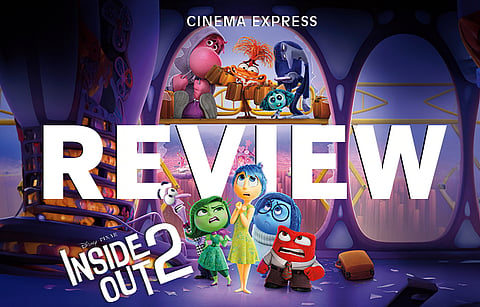Inside Out 2 Movie Review: A colourful rumination on the psychology of self
Inside Out 2 (3.5 / 5)
What psychoanalysis provides as insights, with its dissection of an individual’s thoughts and behaviour, art provides collective wisdom through its dissection of our human condition. Perhaps the biggest triumph and culmination of centuries of art is to try and make sense of our tacit impulses through simple stories about grand adventures and a hero's evolution. Through that lens, it seems like Pixar stands at the very forefront of our modern storytelling mechanism i.e. cinema. In Inside Out 2, which stands among some of the studio's finest works, Pixar discusses complex psychological truths, while playing strictly within the bounds of animation and its playfulness.
Director: Kelsey Mann
Cast: Amy Poehler, Phyllis Smith, Lewis Black, Diane Lane, Kyle MacLachlan, Maya Hawke, Ayo Edebiri
While Inside Out (2015) shows how a child develops her emotions and in that process, learns to accept her darker emotions, Inside Out 2 shows how a teenager deals with more complex emotions as she hits puberty and as a result, develops her sense of self. As the film begins, Joy, Anger, Disgust, Fear, and Sadness are comfortable navigating the emotions of a young Riley. Joy has even created a device that launches Riley’s bad memories to the back of her mind. Everything goes smoothly until, one day, puberty hits, like a group of disorganised construction crew, who barge in and change the console, and immediately afterwards, new emotions arrive: Anxiety, Ennui (Boredom), Embarrassment, and Envy. These new, sophisticated emotions, headed by anxiety, wreck havoc by bottling up the base emotions (quite literally) and take over the console and decide what’s best for Riley. It is charming to see how the film treats the new emotions with empathy, even though all of Riley’s bad decisions and the ensuing chaos unravel after they take control. Considering how these new emotions are the harbingers of the central conflict, they could have been shown as the antagonists to the familiar protagonists—the basal emotions. But the makers are particular about treating this story about human emotions with profound empathy and understanding of the inner workings of psychology.
The nuanced characterisation of the new emotions appears in brief flashes of ingenuity as much as it plays out through the pivotal moments in the film. Through charming dialogues and quirky scenes, we see how some of the older emotions relate to the new emotions: Sadness and Embarrassment reciprocate friendliness right from the beginning; Fear relates to Anxiety's tendency to worry about the future. While the first film was all about the emotions accepting Sadness, the second film thankfully does not just reiterate the arc of the first film. However, the central message of the film is still about self-acceptance but it is dealt with a complex and sophisticated approach. We see Riley develop her sense of self while almost every single emotion goes through their own little character arc. Not unlike the first film, Joy continues to go through the biggest character evolution of all. An argument could be made that the sequel does not quite reach the emotional peak set by the heart-tugging scene in the first film involving Bing Bong. However, a particular moment towards the end of the film almost comes close, where it suddenly hits you with a wave of poetic melancholy. It is the scene where Joy poignantly reflects on her inability to help Riley, and sadly declares, “Maybe that’s what happens when you get older, you feel less joy.” In many ways, Inside Out is as much about a young girl dealing with emotions and growing up as it is about the loss of innocence and the multiple ways in which parts of us die for us to evolve. The Inside Out franchise is about death as much as it is about life. While the first film deals with the death of childish happiness, the second film is about the death of our rose-tinted perception of ourselves. As the emotions learn towards the end of the film, emotions cannot dictate who we are, and that we only have limited control over our sense of self. The film proposes that the world, our environment, our experiences, our ability to rein in our emotions, and both our good and bad memories, all combine to form our belief systems, and our sense of self is built on top of that.
Inside Out 2 is more than just about keeping the emotions in check. Through its deep psychological understanding, the film ponders upon the several complexities of our mind and delivers a philosophical rumination on how we shape our own identity. It is perhaps easier to talk about all the aforementioned philosophies in a straightforward manner but the brilliance of Inside Out 2 lies in how it has fun with the format and keeps a steady hand on the console that makes sure the film is thoroughly entertaining.


